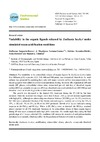Identificador persistente para citar o vincular este elemento:
https://accedacris.ulpgc.es/jspui/handle/10553/41321
| Título: | Variability in the organic ligands released by Emiliania huxleyi under simulated ocean acidification conditions | Autores/as: | Samperio-Ramos, Guillermo Santana-Casiano, J. Magdalena González-Dávila, Melchor Ferreira, Sonia Coimbra, Manuel A. |
Clasificación UNESCO: | 2510 Oceanografía | Palabras clave: | Emiliania huxleyi Acidification Extracellular release Phenolic compounds dissolved uronic acids |
Fecha de publicación: | 2017 | Publicación seriada: | Aims Environmental Science | Resumen: | The variability in the extracellular release of organic ligands by Emiliania huxleyi under four different pCO(2) scenarios (225, 350, 600 and 900 mu atm), was determined. Growth in the batch cultures was promoted by enriching them only with major nutrients and low iron concentrations. No chelating agents were added to control metal speciation. During the initial (IP), exponential (EP) and steady (SP) phases, extracellular release rates, normalized per cell and day, of dissolved organic carbon (DOCER), phenolic compounds (PhCER), dissolved combined carbohydrates (DCCHOER) and dissolved uronic acids (DUA(ER)) in the exudates were determined. The growth rate decreased in the highest CO2 treatment during the IP (<48 h), but later increased when the exposure was longer (more than 6 days). DOCER did not increase significantly with high pCO2. Although no relationship was observed between DCCHOER and the CO2 conditions, DCCHO was a substantial fraction of the freshly released organic material, accounting for 18% to 37%, in EP, and 14% to 23%, in SP, of the DOC produced. Growth of E. huxleyi induced a strong response in the PhCER and DUAER. While in EP, PhCER were no detected, the DUAER remained almost constant for all CO2 treatments. Increases in the extracellular release of these organic ligands during SP were most pronounced under high pCO2 conditions. Our results imply that, during the final growth stage of E. huxleyi, elevated CO2 conditions will increase its excretion of acid polysaccharides and phenolic compounds, which may affect the biogeochemical behavior of metals in seawater. | URI: | https://accedacris.ulpgc.es/handle/10553/41321 | ISSN: | 2372-0344 | DOI: | 10.3934/environsci.2017.6.788 | Fuente: | AIMS Environmental Science [ISSN 2372-0344], v. 4 (6), p. 788-808 |
| Colección: | Artículos |
Los elementos en ULPGC accedaCRIS están protegidos por derechos de autor con todos los derechos reservados, a menos que se indique lo contrario.
